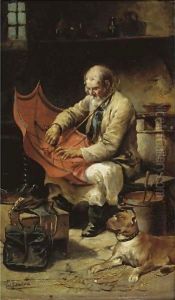Jose De Echenagusia Errazquin Paintings
Jose De Echenagusia Errazquin, also known as José Echenagusía or Echenagusia Errazkin, was a Basque painter born in the port town of Getaria, in the province of Gipuzkoa, Basque Country, Spain on October 3, 1844. He grew up in a time when the Basque region was experiencing significant changes, both culturally and politically. Despite the lack of detailed personal records that are commonly available for some artists, Echenagusia's contributions to the art world, particularly through his paintings, have garnered him a place in the annals of Spanish art history.
Echenagusia studied painting in Madrid at the Royal Academy of Fine Arts of San Fernando, which was the leading art institution in Spain at the time. His education there would have been rooted in the academic traditions of the 19th century, emphasizing technical skill, a mastery of perspective, and an adherence to classical and historical subjects.
After his studies, Echenagusia traveled to Rome, which was a typical practice for artists of his era who sought exposure to the works of the Renaissance and classical antiquity. His time in Italy likely influenced his artistic style, which blended traditional academic techniques with the light and color more characteristic of the impressionists who were gaining prominence during his lifetime.
Echenagusia's work was primarily focused on genre scenes, portraits, and landscapes, often highlighting his Basque heritage. He was known for capturing the cultural and social nuances of Basque life, a theme that resonated throughout his career. His works often depicted the sea and the lives of fishermen, reflecting his coastal roots. Echenagusia's paintings were well-received, and he participated in numerous exhibitions, including national exhibitions in Spain and international expositions, where he earned recognition and awards.
Despite his success, Jose De Echenagusia Errazquin remains a somewhat obscure figure outside of Spanish art history. He died on April 24, 1912, in his birthplace of Getaria. Today, his works can be found in various Spanish museums and collections, where they stand as a testament to the rich cultural tapestry of the Basque region and the broader artistic movements of the 19th century.
